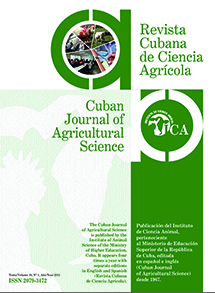Biophysical effect of climate change on summer crops
Contenido principal del artículo
Resumen
The effect of climate change on yield of soybean and maize crops was determined in Azul, Buenos Aires, Argentina. DSSAT crop models, previously calibrated, were used, under local conditions. Projections of PRECIS regional climate model in the SRESA2
stage were used, for the decades 2020-29 and 2050-59, in order to obtain potential yields. Later, the effect of heat waves during the growth cycle 2013-14 was evaluated. Climate projections indicated an increase of yields of crops during dryland farming
crops. In soybean (Glycine max (L.) Merr.), the increase was 25 and 28 %, and in maize (Zea mays), it was 19 % and 26 %, for the decades 2020-29 and 2050-59, respectively. However, considering thermal variability imposed by the heat wave, it was evident
that soybean and maize showed a reduction of yield when they are sown without irrigation during those extreme events. Yield decreases reach 19 % in soybean and 36 % in maize. Comparing yields of crops irrigated in a year considered as typical with respect
of the year of heat wave, the increase of temperature benefits maize with a 22 % of yield increase, but harms soybean with a decrease of 13 %. Influence of temperature increase, together with water deficiencies, produces different effects on C3 species like soybean,
and in C4 like maize. It is suggested to develop more research on the effects of extreme phenomena on different phenological phases of crops so the sustainability of agroecosystems from the center of Buenos Aires province could be mantained.
Key words: food safety, heat wave, soybean, maize
stage were used, for the decades 2020-29 and 2050-59, in order to obtain potential yields. Later, the effect of heat waves during the growth cycle 2013-14 was evaluated. Climate projections indicated an increase of yields of crops during dryland farming
crops. In soybean (Glycine max (L.) Merr.), the increase was 25 and 28 %, and in maize (Zea mays), it was 19 % and 26 %, for the decades 2020-29 and 2050-59, respectively. However, considering thermal variability imposed by the heat wave, it was evident
that soybean and maize showed a reduction of yield when they are sown without irrigation during those extreme events. Yield decreases reach 19 % in soybean and 36 % in maize. Comparing yields of crops irrigated in a year considered as typical with respect
of the year of heat wave, the increase of temperature benefits maize with a 22 % of yield increase, but harms soybean with a decrease of 13 %. Influence of temperature increase, together with water deficiencies, produces different effects on C3 species like soybean,
and in C4 like maize. It is suggested to develop more research on the effects of extreme phenomena on different phenological phases of crops so the sustainability of agroecosystems from the center of Buenos Aires province could be mantained.
Key words: food safety, heat wave, soybean, maize
Detalles del artículo
Cómo citar
Confalone, A. E., Vilatte, C. A., Aguas, L. M., Barufaldi, M. F., Eseiza, M. F., & Ponce, G. D. (2017). Biophysical effect of climate change on summer crops. Cuban Journal of Agricultural Science, 51(2). Recuperado a partir de https://cjascience.com/index.php/CJAS/article/view/717
Sección
Ciencia de los pastos y otros cultivos
Aquellos autores/as que tengan publicaciones con esta revista, aceptan los términos siguientes:
- Los autores/as conservarán sus derechos de autor y garantizarán a la revista el derecho de primera publicación de su obra, el cuál estará simultáneamente sujeto a la Licencia Creative Commons Attribution-NonCommercial 4.0 International (CC BY-NC 4.0) que permite a terceros compartir la obra siempre que se indique su autor y su primera publicación esta revista. Bajo esta licencia el autor será libre de:
- Compartir — copiar y redistribuir el material en cualquier medio o formato
- Adaptar — remezclar, transformar y crear a partir del material
- El licenciador no puede revocar estas libertades mientras cumpla con los términos de la licencia
Bajo las siguientes condiciones:
- Reconocimiento — Debe reconocer adecuadamente la autoría, proporcionar un enlace a la licencia e indicar si se han realizado cambios. Puede hacerlo de cualquier manera razonable, pero no de una manera que sugiera que tiene el apoyo del licenciador o lo recibe por el uso que hace.
- NoComercial — No puede utilizar el material para una finalidad comercial.
- No hay restricciones adicionales — No puede aplicar términos legales o medidas tecnológicas que legalmente restrinjan realizar aquello que la licencia permite.
- Los autores/as podrán adoptar otros acuerdos de licencia no exclusiva de distribución de la versión de la obra publicada (p. ej.: depositarla en un archivo telemático institucional o publicarla en un volumen monográfico) siempre que se indique la publicación inicial en esta revista.
- Se permite y recomienda a los autores/as difundir su obra a través de Internet (p. ej.: en archivos telemáticos institucionales o en su página web) antes y durante el proceso de envío, lo cual puede producir intercambios interesantes y aumentar las citas de la obra publicada. (Véase El efecto del acceso abierto).
